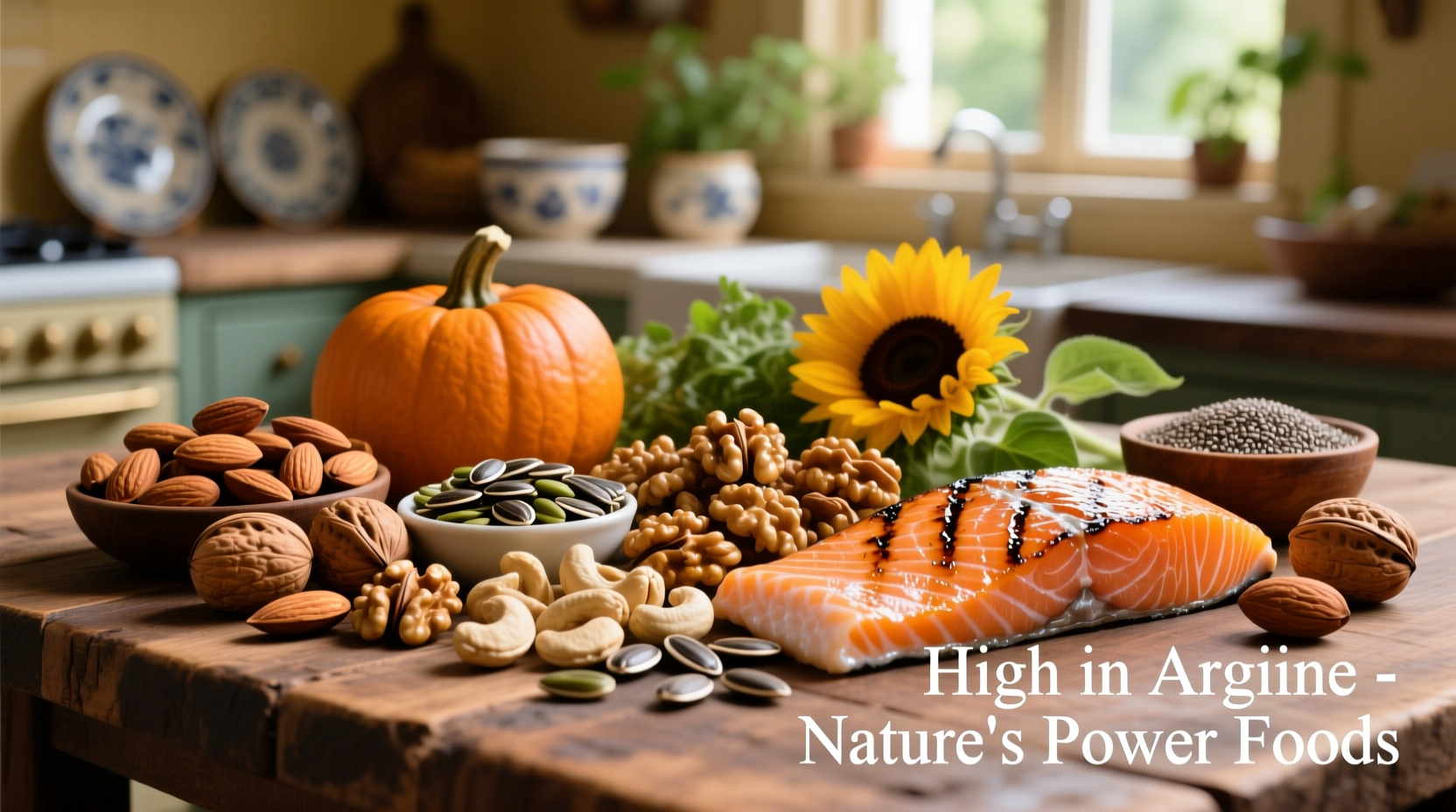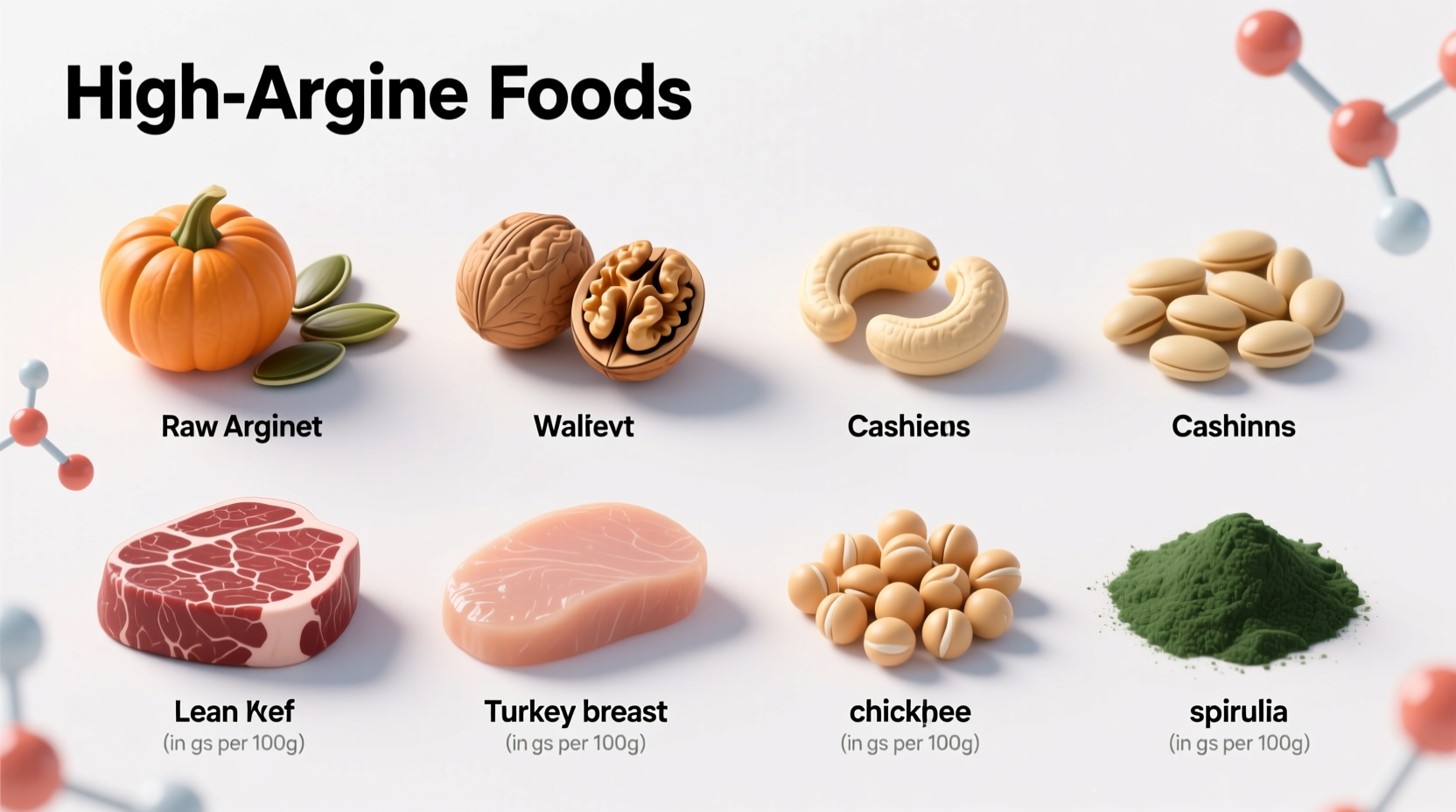Top arginine-rich foods include pumpkin seeds (7.0g per 100g), turkey breast (5.6g), soybeans (4.6g), peanuts (4.2g), and chicken (3.9g). This essential amino acid supports cardiovascular health, immune function, and exercise recovery. Adults typically need 2-3 grams daily, easily obtainable through balanced dietary sources rather than supplements.
Discover exactly which foods deliver the most arginine to support your health goals. Whether you're an athlete optimizing performance, managing cardiovascular concerns, or simply building a nutrient-dense diet, this guide provides science-backed food sources with precise arginine measurements from authoritative nutritional databases.
Why Arginine Matters for Your Health
Arginine serves as a building block for proteins and transforms into nitric oxide in your body—a compound critical for blood vessel function. This amino acid supports multiple physiological processes:
- Enhances blood flow and cardiovascular health
- Supports wound healing and tissue repair
- Boosts immune system function
- Aids exercise performance and recovery
- Helps maintain healthy blood pressure levels
While your body produces arginine naturally, dietary intake becomes crucial during growth periods, recovery from injury, or intense physical training. Unlike supplements, whole food sources provide arginine alongside complementary nutrients that enhance absorption and utilization.
Top Arginine Food Sources by Category
Nuts and Seeds
These convenient snacks deliver impressive arginine concentrations alongside healthy fats and fiber:
| Food | Arginine (per 100g) | Serving Size | Arginine per Serving |
|---|---|---|---|
| Pumpkin seeds | 7.0g | 1 oz (28g) | 1.96g |
| Peanuts | 4.2g | 1 oz (28g) | 1.18g |
| Pistachios | 2.3g | 1 oz (28g) | 0.64g |
| Almonds | 2.2g | 1 oz (28g) | 0.62g |
According to USDA FoodData Central measurements, pumpkin seeds contain nearly 25% more arginine than the next highest nut source. These measurements reflect raw, unsalted varieties—roasting causes minimal nutrient loss.
Animal Proteins
Meat and poultry provide complete protein profiles with substantial arginine content:
- Turkey breast (5.6g per 100g) - A 3-ounce serving delivers approximately 1.7g arginine
- Chicken breast (3.9g per 100g) - Contains more arginine than most red meats
- Pork loin (3.4g per 100g) - Provides additional zinc and B vitamins
- Salmon (2.3g per 100g) - Offers omega-3 fatty acids alongside arginine
Plant-Based Proteins
Vegans and vegetarians can access substantial arginine through these sources:
- Soybeans (4.6g per 100g) - Edamame provides 2.3g per half-cup serving
- Chickpeas (1.5g per 100g) - Hummus makes arginine absorption more efficient
- Lentils (1.3g per 100g) - Combine with grains for complete protein
- Pumpkin seeds - The plant-based arginine champion
Research published in the American Journal of Clinical Nutrition confirms that plant-based arginine sources maintain bioavailability when consumed as part of balanced meals. The fiber content in plant foods actually enhances arginine utilization compared to isolated supplements.
Practical Dietary Integration
Meeting your daily arginine needs requires strategic food combinations rather than relying on single sources. Here's how to incorporate these foods effectively:
Daily Arginine Meal Plan
- Breakfast: Greek yogurt with pumpkin seeds and berries (1.8g arginine)
- Lunch: Chickpea salad with turkey slices (2.1g arginine)
- Snack: Handful of pistachios (0.6g arginine)
- Dinner: Salmon with edamame and quinoa (2.5g arginine)
This sample plan delivers approximately 7g of arginine—well above the recommended 2-3g daily requirement. The variety ensures you receive complementary nutrients that enhance arginine's physiological effects.

Important Considerations
While arginine offers significant health benefits, certain conditions require careful management:
- Herpes virus: Some research suggests arginine may trigger outbreaks—balance with lysine-rich foods like dairy
- Low blood pressure: Consult your physician before increasing arginine intake significantly
- Post-surgery recovery: Arginine supplementation shows promise but requires medical supervision
The National Institutes of Health notes that food-based arginine poses minimal risk compared to high-dose supplements. Whole foods provide arginine in natural ratios with other amino acids that prevent potential imbalances.
Maximizing Arginine Benefits
You can enhance arginine's effectiveness through these evidence-based strategies:
- Combine arginine-rich foods with vitamin C sources to boost nitric oxide production
- Avoid excessive heat when cooking to preserve amino acid integrity
- Pair plant-based sources with whole grains for complete protein profiles
- Consume arginine-containing foods 60-90 minutes before exercise for optimal performance benefits
Studies from the Journal of the International Society of Sports Nutrition demonstrate that dietary arginine timing significantly impacts exercise performance and recovery compared to random consumption patterns.
Frequently Asked Questions
How much arginine do I need daily from food sources?
Most adults require 2-3 grams of arginine daily, achievable through balanced eating. Athletes or those recovering from injury may benefit from 4-5 grams. A single ounce of pumpkin seeds provides nearly 2 grams, making it exceptionally efficient for meeting daily needs through whole foods.
Can I get enough arginine on a vegetarian diet?
Absolutely. Plant-based sources like pumpkin seeds (7g/100g), soybeans (4.6g/100g), and peanuts (4.2g/100g) provide substantial arginine. Combining legumes with whole grains creates complete protein profiles that enhance arginine utilization. Vegetarian diets often deliver comparable or higher arginine levels than meat-based diets when properly planned.
Does cooking destroy arginine in foods?
Minimal arginine loss occurs with normal cooking methods. Boiling causes slight leaching into water (about 5-10%), while roasting nuts and seeds preserves nearly all arginine content. Avoid charring or burning foods, as extreme heat can degrade amino acids. Steaming and gentle sautéing maintain maximum nutrient retention.
Are there risks associated with high-arginine foods?
Food-based arginine presents minimal risks. Those with herpes simplex virus should monitor intake as arginine may trigger outbreaks in susceptible individuals. People with low blood pressure or taking blood pressure medication should consult their physician before significantly increasing arginine-rich foods. Unlike supplements, whole food sources provide balanced nutrient profiles that prevent potential adverse effects.
Which cooking methods best preserve arginine content?
Gentle cooking methods preserve arginine most effectively. Steaming legumes retains nearly 100% of arginine, while boiling causes minimal leaching (5-10%) into cooking water. For nuts and seeds, dry roasting at low temperatures (under 300°F) preserves amino acid integrity better than frying. Avoid charring or burning foods, as extreme heat degrades amino acids. Raw consumption provides maximum arginine retention when appropriate for the food type.











 浙公网安备
33010002000092号
浙公网安备
33010002000092号 浙B2-20120091-4
浙B2-20120091-4